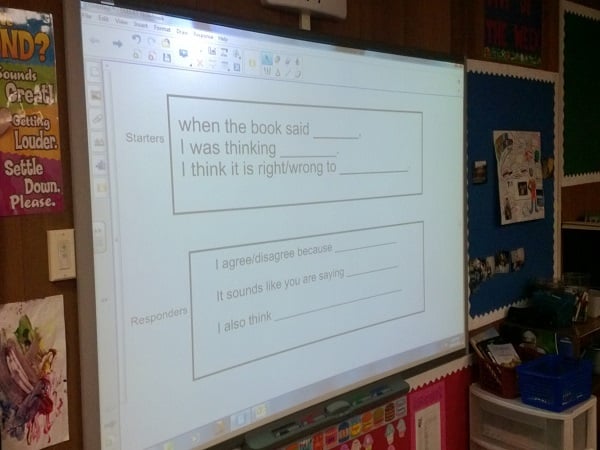Should Reading Teachers Follow a Script?

Ask any group of teachers whether they should follow a script, and you're likely to get a range of strong opinions. Some teachers feel that scripting limits creativity and takes away their professional voice, while others see it as a helpful roadmap.
So...should reading teachers follow a script?
The simple answer is, yes!

Why a Script Matters
I still remember my first year teaching. I was given a reading curriculum that consisted of an anthology of stories—one per week, and a menu of reading skills and strategies lessons. There was more offered than could be taught in a single week, including scaffolds for the lowest students and extensions of the high students. It was my job to choose from the lengthy list of menu options and put together my own lesson sequence. I was thrilled! I would finally be able to put my teaching skills to the test!
After the first unit, I was exhausted. All my energy had gone into daily planning, and I could hardly keep up. Every time I taught a lesson to my class, I was thinking through how I would write and teach the next set of lessons. Mentally, I was always in two places at once. How could I keep this up for the whole school year? Would my students benefit from this type of on-the-go teaching?
I turned to my colleagues for support and found each one of them was going about their curriculum planning differently. The only consistency in our reading program was the stories themselves; when it came to the skills, each one of us was teaching them a little differently.

Five Reasons to Follow a Lesson Script
Most teachers would argue that teaching from a script is confining, but I disagree. It's freeing! Teaching with a script frees up our mental energy and allows us to redirect that energy to the students. A script ensures consistency and quality, but most importantly, it ensures that we can smartly adapt.
Teaching with a lesson script
1. guarantees that teachers are consistently using the same language.
What is the difference between a key idea and a detail? What is the difference between the theme and the author's message? What are the most important events of the plot line? A scripted curriculum ensures teachers are on the same page when it comes to questions like these. Consistency of language makes a big difference for learning outcomes. When the language in the classroom is consistent, it creates a predictable learning enviornment for students and reduces the cognitive load. This leads to academic success.
2. ensures all students are getting the same quality of instruction.
Following a script is not just about keeping everyone "on the same page". It's about guaranteeing every student receives the same instruction, no matter which classroom they are in.
3. provides a clear and meaningful sequence for learning.
The best lessons intentionally include opportunities for the gradual release of responsibility; lessons move from teacher modeling to guided practice. Students demonstrate learning through independent or small group work.
4. supports teachers in providing the scaffolding and differentiation to allow all students to experience success.
The best lessons will include the following strategies to support a variety of learners; content and language objectives, differentiated texts, the use of graphic organizers, think-aloud strategies, explicit vocabulary instruction, varied group sizes, discussion stems, and more.
5. frees up a teacher's time and cognitive capacity.
The script reduces the teacher's mental load so that he/she has the capacity to make smart modifications as needed.

Modifying the Script
Who said that following a script isn't fun? A well-written script will increase a teacher's confidence to use their professional instincts. When teachers have the freedom and the headspace to modify or add to a lesson, their passion for teaching comes to life. For teachers, that's considered "fun"!
Here are some examples of how teachers can use their professional passion to modify a well-written script:
- Be ready for the teachable moments! No curriculum writer can anticipate everything that might happen in a lesson. Are students stumbling over a multi-syllabic word? When this happens, a good teacher will take a moment to demonstrate how to decode the word by breaking the word into syllables, for example. Are students struggling with a complicated set of dialogue? A good teacher calls attention to how to read tricky dialogue and models for the students. Teachable moments are used sparingly so that the focus and pace of the lesson isn't compromised.
- Help students make meaningful connections across content areas, to current events, or the local community. The teacher has a unique advantage of knowing the content of what is being taught in the other classes and knows the events that are happening in the world or in the local community. A passionate teacher will find creative ways to draw attention to these connections, making the curriculum come alive for students.
- Adjust the lesson for the needs of the students. Trained teachers know when to provide additional examples or model the skill again if students need more support. They add extra opportunities for students to practice the skill if needed and bring in visual examples to support multi-lingual learners. As students demonstrate learning, teachers stretch the thinking further.
- Be real. The best teachers bring in the humor and add the fun! They show a little of their own personality, sharing their own struggles and successes as a reader. This personal touch that only the teacher can bring goes a long way to increase the feeling of classroom community and empowers students to take risks and be themselves.
While it may be tempting to personalize every lesson, be careful that going "off script" doesn't lead to inconsistencies that affect student outcomes. Teachers may know their students' needs better than anyone, but few have time—or the cross-grade expertise—to write a fully cohesive curriculum on their own.

Teaching a Shared Curriculum
A shared curriculum with well-designed scripts doesn't have to take away from the joy of teaching; it can amplify it! A strong lesson script that is ready-to-go gives teachers the freedom and bandwidth to create classrooms that are consistent, equitable, and full of authentic learning. If a script can bring teachers those kinds of results, I'm in!

Are you looking for a well-designed curriculum that uses scripts to increase success?
We are confident the Read Side by Side Reading Program will be the right fit for your next curriculum adoption! To learn more about the program and request a sample kit, connect with one of our advisors!

Written by Sarah Collinge
Founder & President
Read Side by Side Publications, LLC.
Sarah is the author of Raising the Standards through Chapter Books, 2nd Edition and the Read Side by Side Reading Program. Her work is impacting schools across the world that desire to increase students' confidence and motivation in reading. Her eleven years teaching intermediate students in Title 1 schools brings credibility to her work. Connect with Sarah!

.png)

